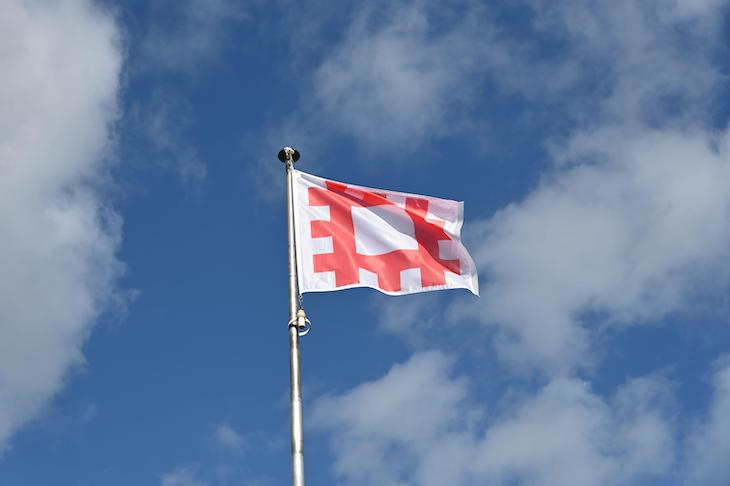Easter is, of course, the time of year when Christians celebrate the death and resurrection of Jesus Christ, but don’t expect to learn that on the English Heritage children’s Easter trail.
‘Did you know Easter started as a celebration of spring?,’ children who take part in the trail are told. Any mention of Christ or Christianity is omitted from that sign, which has been planted at English Heritage sites across the country. However, one god does get a look in. This first panel, decorated with children collecting flowers, painted eggs and a cheery Easter bunny, gave the following account of the origin of Easter:
‘Long ago, people welcomed warmer days and new life by honouring the goddess Eostre, who gave Easter its name!’
The sign then relates a further ‘Fun Fact’:
‘Some traditions for Eostre included dancing around bonfires and decorating homes with flowers.’
The sign may be charming for young children, but it is almost completely devoid of truth. It’s somewhat worrying that an organisation charged with looking after our country’s heritage is willing to put its logo on such a sign.

English Heritage could do with a history lesson. The only mention of the goddess Eostre in the whole corpus of ancient and medieval literature is made by the great Anglo-Saxon scholar, the Venerable Bede (673-735). In one work, The Reckoning of Time (De Temporum Ratione, chapter 15) he explains the origins of the Anglo-Saxon names of the months. April had the Anglo-Saxon name of ‘Eosturmonath’. This, he said, was now designated as ‘Paschal month’ but that it was once called after a goddess ‘Eostre’ in whose honour during that month feasts were celebrated. In England, he then says, the Paschal season had taken her name, or the name of the month (his Latin is unclear on the point), designating the joys of the new ritual (i.e. the Christian celebration of the death and resurrection of Christ) by the old observances.
There are many things conspicuously absent from Bede’s account. We do not know of what Eostre was a goddess, nor do we have any evidence of specific customs in celebration of her, certainly not dancing round bonfires nor flower decorations. There is no evidence that her festivals were connected with the spring. There is certainly no mention of Easter eggs nor Easter bunnies, nor any such customs connected to her or to the Easter season in other Anglo-Saxon writing.
Indeed, some scholars doubt whether Bede, despite his careful scholarship, might have even been mistaken about the very existence of Eostre as a goddess. Certainly, he is very vague about her; one conjecture is that he derived her existence from the name of the month, rather than vice versa. Others use evidence of place or personal names to argue for her existence. The first part of Austerfield, a village in Yorkshire, for example, may be cognate to ‘Eostre’ and thus once have been a shrine to her. Near Morken-Harff in southern Germany, a number of offerings were made to the matronae Austriahenae, a triad of goddesses, whose name might also be related to ‘Eostre’. But even if this shows her existence, it does not tell us anything about her character.
But with the Christian Easter, i.e. the festival of Christ’s resurrection, we are on much surer ground. Literary evidence shows its regular celebration long before Anglo-Saxon times. Writings of Melito, Bishop of Sardis, show that it was certainly established by the mid-second century AD. Even by that point, people were arguing about on what date is should be celebrated. Some argued for it to be on the same date as the Jewish Passover, at which time the gospels recorded Christ’s death and resurrection to have taken place, whilst others wished it to be on a nearby Sunday. It is likely to have been celebrated in the British Isles in the late Roman empire, but we have no written evidence to show this. However, Bede’s history attests that soon after St Augustine’s mission from Rome to convert Britain in 597 Easter was being celebrated, and indeed, that arguments about its date continued here until the Synod of Whitby in 664. In England, Easter takes its existence, meaning, and date from Christian doctrine, and only its name from the Anglo-Saxon past.
English Heritage’s own webpage on Easter is in marked contrast to its trail. Acknowledging Easter’s Christian origins from the beginning, it is scholarly and engaging, with tales of the origins of the hot-cross bun, the Leicester Easter Monday Hare Hunt (the hare apparently replaced with a dead cat soaked in aniseed water by the eighteenth century) and an informed discussion of the history of egg-rolling. In this properly written and researched history there is plenty to keep children engaged. One must devoutly wish that this Easter Trail panel is not a sign of English Heritage’s intended direction of travel, but rather a moment of aberration, just like the mad March hare.







Comments